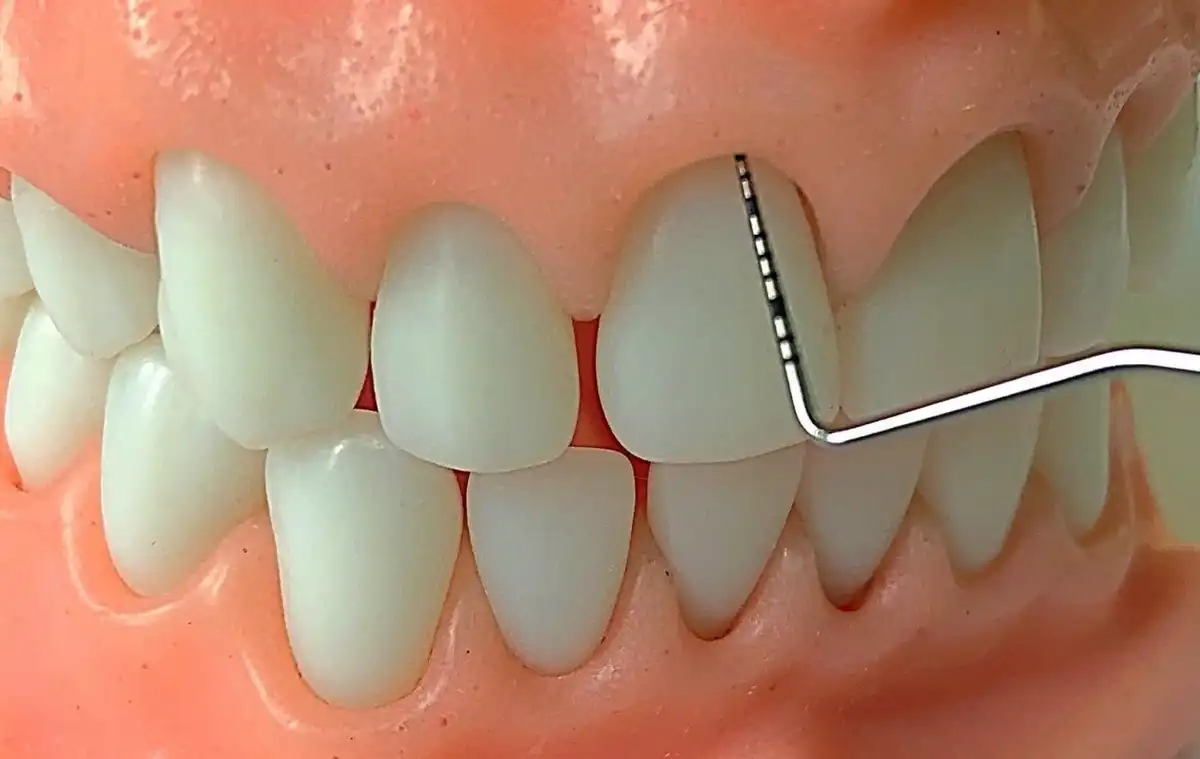What Is Perio Charting & Why Is It Important?


Have you ever been to your dentist for a checkup and heard them call out a list of what seems like 300 different numbers?
“3…2…1…2…3….”
What does it mean?
If you have, this is an essential part of your annual dental exam called a “periodontal charting”, “perio screening”, or “probing.”
Perio charting, aka “probing”, is an important part of your regular dental checkups. It’s something your dentist or hygienist does to check the health of your gums, bone, and other tissues around your teeth.
You can tell you’re getting your teeth perio charted when you hear them call out a bunch of numbers in a row, like “3…2…3…3…2…” etc. During this process, your hygienist or dentist is using an ultra-small measuring device around each tooth that reads out in millimeters to measure where your gums attach to your teeth.
Don’t worry. As long as your gums are healthy, getting them measured doesn’t hurt. However, you could feel some irritation or even bleed if you have some type of gum disease around the tooth that’s being measured.
What’s The Point Of Perio Charting?
When used alongside of your annual dental X-rays (which are ESSENTIAL for screening for bone loss,) periodontal charting shows us the attachment level between your gum tissues and the roots of your teeth (aka “pocket”.)
Different pocket depths mean different things when it comes to how healthy your mouth is. To understand the significance of the measurements and if you need to be concerned or not, here are what the probing depths equate to:
Healthy Gums: 1-3 Mm Pockets
When we talk about a healthy smile that has gum attachment levels within normal limits, your pocket measurements will be between 1-3mm deep. The natural anatomy of a healthy tooth has a tiny, tiny pocket (sulcus) that you can clean with your floss or water flosser.
When you measure the natural space between your gums and teeth, a healthy mouth that’s “within normal limits” will have a sulcus (pocket) about 1-3mm deep from where the tool touches the bottom of the pocket to the edges of the gums. Your dentist uses a small probe that works like a ruler to measure this space, except it measures out in millimeters.
As long as your gums stay in the 1-3 range, all you need to do is schedule a preventative dental cleaning twice a year (and keep flossing every day.)
Gingival Inflammation: 4 Mm Pockets
If you have mild to moderate gingivitis, it causes your gums to swell. This can create what we in the dental world call a “pseudo-pocket” that makes it LOOK like you have a deeper gum pocket, but in reality, the extra depth is coming from swelling on the edges of your gumlines.
Even if your mouth is relatively healthy, you might occasionally have a 4mm pocket pop up on your perio charting. Usually, this is minor inflammation caused by gingivitis. The swelling along your gumlines creates a “pseudo-pocket” or false pocket, just because the edges are swollen and make the pocket seem deeper.
The good news is that gingivitis is totally reversible with good home care, brushing, flossing/water flossing, and other adjunctive tools. Once that inflammation goes down, your pocket will usually go back to 3mm.
Perio Pockets: 5 Mm Pockets
Now we’re getting serious. A gum pocket that’s 5mm deep means your body is responding to plaque and tartar buildup under the gums, causing your gums to detach from your teeth.
Once you have a 5mm pocket show up, it usually means that there’s some associated bone loss. At this point, it becomes an area of concern for both you and your dentist, as 5mm pockets tend to indicate periodontal (gum) disease.
Why does that matter? Because gum disease is the leading cause of adult tooth loss. Once we lose bone, we can’t get it to grow back. Deeper pockets are hard to clean, so at this point you need the extra help from your dentist to treat the infection.
At this point, your body is also starting to lose bone support around the teeth. Fast action (like a deep cleaning or “SRP”) may be required to prevent anything from getting worse.
Periodontal Disease: Pockets 5mm & Up
We’ve reached the point of no return. Unless these deep pockets are cleaned by a professional, you’re not going to be able to stop the gum detachment and bone loss from getting worse.
If you have localized 4 or 5mm pockets, your dentist can sometimes just do a thorough cleaning and watch that area. But when you have generalized pockets that are 5, 6, 7mm or deeper scattered all throughout your mouth, there’s a bigger issue going on.
Usually, a deep cleaning (SRP) is necessary to stop the infection and prevent extra bone or tooth loss. After an SRP, you’ll usually have your teeth cleaned more frequently to prevent relapse. At this point, the goal is to just keep the pockets from getting any deeper. Aggressive periodontitis will ultimately lead to tooth loss without your dentist’s help. Yikes.
How Do I Keep My Gums Healthy?
Remember - it’s normal to have shallow gum pockets around your teeth. However, if you don’t keep them clean with brushing and flossing (or our favorite, water flossing) then the gums will get inflamed and infected.
It’s considered standard of care to have a periodontal exam at least once a year to check your gums. If your dentist isn’t measuring your gum pockets, you could have periodontitis and bone loss without even knowing it. When you have both perio charting and routine X-rays, all of that data can help identify areas of concern so that you can treat gum problems as early as possible.
Even people with good oral hygiene sometimes get gum pockets. With perio charting you can spot problems early, while they’re still reversible.
Regular preventative dental cleanings every six months will help you avoid heavy tartar buildup, which is a huge factor when it comes to deeper perio charting depths.
To keep your gums free of inflammation and make sure you don’t have pockets over 3mm during perio charting, you need to make sure you’re cleaning your gumlines and between teeth daily. Use a soft toothbrush, floss, water flosser, or interdental brush to make sure you’re lifting every piece of plaque away from your teeth and gums each day.

What If I Have Perio Pockets?
If your perio charting reveals a few 5mm pockets, your dentist and hygienist will probably suggest an “SRP” (deep cleaning, aka scaling and root planing.)
During your deep cleaning, they’ll numb one side of your mouth to clean out all of the pockets and the tartar that’s inside of them. Then, you'll schedule another appointment to clean the other side of your mouth. This staggered process prevents you from going home with a completely numb mouth (trust us, you don’t want that!)
The sooner you pay attention to your perio charting numbers, the earlier you can catch deep pockets. When they’re shallow (like 4mm) they’re usually still reversible because they’re caused by inflammation. But if they’re deeper, you need to be cleaning inside of them each day to prevent further gum detachment. A water flosser is an excellent resource.
Side note: gum recession is NOT the same thing as a perio pocket. That’s a totally different subject for another day! From there on out, you might need to have your teeth cleaned every 3-4 months until your gum pockets show improvement. Everybody is different. Everyone heals in different ways. Your dentist and hygienist will let you know what’s best for your specific situation.
Perio Pocketing Recap
Cleaning your pockets regularly, a deep cleaning/SRP, and a re-vamped home hygiene plan will help prevent the plaque and tartar buildup responsible for making your pockets even deeper.
- periodontal probing and X-rays are an important part of your annual dental exam. Without them, it’s impossible to examine your bone level and if there's any tartar buildup below the gum line.
- if you have deep gum pockets at 5mm or more, bone loss is starting to occur around your teeth.
- a deep cleaning (SRP) removes tartar buildup, and stops gum detachment and bone loss from happening.
If you’re not sure of the last time you had your mouth probed, be sure to ask your hygienist about your periodontal levels during your next checkup!

Make your inbox smile!
Subscribe






